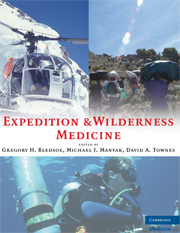Book contents
- Frontmatter
- Contents
- Contributors
- Foreword
- Preface
- Acknowledgments
- PART I EXPEDITION PLANNING
- PART II EXPEDITIONS IN UNIQUE ENVIRONMENTS
- 13 Tactical and Protective Medicine
- 14 Hostile Geopolitical Environments
- 15 Aerospace Medicine
- 16 Polar Medicine
- 17 Tropical Medicine for Expeditions
- 18 Subterranean Medicine
- 19 High-Altitude Medicine
- 20 Medicine at Sea
- 21 Event Medicine
- 22 Telemedicine in Evolution: Implications for Expeditionary Medicine
- 23 Dive Medicine
- PART III ILLNESS AND INJURIES ON EXPEDITIONS
- APPENDIX The Expedition Medical Kit
- Index
14 - Hostile Geopolitical Environments
from PART II - EXPEDITIONS IN UNIQUE ENVIRONMENTS
Published online by Cambridge University Press: 05 March 2013
- Frontmatter
- Contents
- Contributors
- Foreword
- Preface
- Acknowledgments
- PART I EXPEDITION PLANNING
- PART II EXPEDITIONS IN UNIQUE ENVIRONMENTS
- 13 Tactical and Protective Medicine
- 14 Hostile Geopolitical Environments
- 15 Aerospace Medicine
- 16 Polar Medicine
- 17 Tropical Medicine for Expeditions
- 18 Subterranean Medicine
- 19 High-Altitude Medicine
- 20 Medicine at Sea
- 21 Event Medicine
- 22 Telemedicine in Evolution: Implications for Expeditionary Medicine
- 23 Dive Medicine
- PART III ILLNESS AND INJURIES ON EXPEDITIONS
- APPENDIX The Expedition Medical Kit
- Index
Summary
INTRODUCTION
Traveling and working in conflict areas or regions with significant political volatility requires a far more detailed understanding of the unique attributes of conflict areas. Civilians should only consider the prospect of traveling or working in an active war zone under well-defined circumstances, such as with a reputable relief organization or another organization that has significant logistical and security capability. This chapter focuses on two major themes: the complexities of traveling in hostile geopolitical environments and the unique features of providing medical services to populations affected by war.
Most physicians and medical personnel practice in relatively safe and stable environments, although some health care providers have chosen to work in conflict settings that have some degree of political instability and personal danger. To an inexperienced health worker, remote climates may seem inherently dangerous, but the opposite is often the case. Practicing in a rural setting in Somalia, for example, may be remote and relatively austere, but is likely to be safe and secure, while working in inner city Nairobi, Kenya, may be much more dangerous.
Judging whether a certain geographical region is dangerous requires significant knowledge of the unique political, economic, social, and cultural context. It's important to realize the relative risk of travel itself and the likely causes of mortality in travelers. The greatest killer of travelers is cardiovascular disease and accidental injuries, most commonly motor vehicle accidents.
- Type
- Chapter
- Information
- Expedition and Wilderness Medicine , pp. 174 - 183Publisher: Cambridge University PressPrint publication year: 2008



